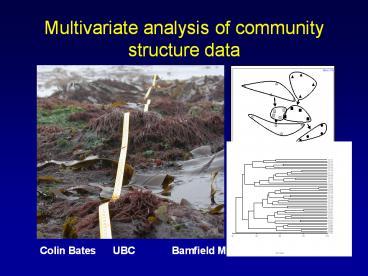Multivariate analysis of community structure data PowerPoint PPT Presentation
1 / 71
Title: Multivariate analysis of community structure data
1
Multivariate analysis of community structure data
Colin Bates UBC Bamfield Marine
Sciences Centre
2
Goals
- To understand the ideas behind multivariate
community structure analysis. - To understand how to perform these analyses in
PRIMER. - To be prepared to analyse and interpret your
class data later today.
3
What are multivariate statistics?
Statistics that allow us to look at how multiple
variables change together
4
What are multivariate statistics?
Statistics that allow us to look at how multiple
variables change together EG How do 50 species
in a community react to an environmental
perturbation?
5
What are multivariate statistics?
- Statistics that allow us to look at how multiple
variables change together - EG How do 50 species in a community react to an
environmental perturbation? - 50 ANOVAs?
6
What are multivariate statistics?
- Statistics that allow us to look at how multiple
variables change together - EG How do 50 species in a community react to an
environmental perturbation? - 50 ANOVAs? No
- Multivariate stats allow us to condense
information for simplicity
7
When might I use this type of analysis?
- For a multi-species community, you may wish to
- pull order from complex systems
- visualize these patterns
- comparisons over time and space
- test hypotheses
8
The vehicle
9
Example Seaweed Communities at Cape Beale
- Is flora different at two close sites, each
exposed to different wave intensity?
10
Data collection
11
2. Data Analysis
Step 1 Entering your data into PRIMER
12
(No Transcript)
13
(No Transcript)
14
(No Transcript)
15
How to analyze this type of data?
1. Diversity indices
16
How to analyze this type of data?
1. Diversity indices Yet, most diversity indices
do not consider species identity
17
How to analyze this type of data?
1. Diversity indices Yet, most diversity indices
do not consider species identity
Multivariate community structure analyses
18
Analysis flow
samples
species
sample similarities
ordination
How?
are sites different?
19
Analysis flow
samples
species
sample similarities
ordination
Calculate Bray Curtis Similarity ? gives a
triangular similarity matrix
20
(No Transcript)
21
(No Transcript)
22
(No Transcript)
23
within
within
between
24
Analysis flow
samples
species
sample similarities
ordination
How?
are sites different?
25
Visualizing similarities
Ordination maps similarity relationships
between samples
26
nMDS ordination example
27
nMDS ordination example
Distance between points reflects relative
similarity!
28
Nonmetric multidimensional scaling (nMDS)
the future of ordination is in nonmetric
multidimensional scaling McCune Grace, 2002
Nonmetric no axes Multidimensional represents
relationships between multiple variables in two
or three dimensions Scaling the ratio between
reality and representation
29
How does nMDS work?
nMDS uses the RANK ORDER of similarity
relationships between samples
A1 is closer to A2 than it is to A3
30
How does nMDS work?
Then, nMDS tries to place points in 2 (or 3)
dimensional space to represent this ranked order
A3
A1 is closer to A2 than it is to A3
A1
A2
31
How does nMDS work?
Then, nMDS tries to place points in 2 (or 3)
dimensional space to represent this ranked order
A1 is closer to A2 than it is to A3
32
How accurate is the nMDS map?
- Sometimes the nMDS cant represent all
relationship accurately - this is reflected by a
high STRESS value
33
How accurate is the nMDS map?
- Sometimes the nMDS cant represent all
relationship accurately - this is reflected by a
high STRESS value
If Stress Value 0.0 perfect map 0.1 decent
map 0.2 ok map 0.3 dont bother
.
.
.
.
.
.
.
.
.
.
.
.
similarity in sim. matrix
.
.
.
.
.
.
.
.
distance on nMDS
34
Main points about ordination!
- Ordination is a way to visualize how similar
your samples are - - nMDS tries to represent visually the rank order
within the underlying similarity matrix - all that matters is the relative distance
between points. - stress value allows you to estimate quality of
the nMDS
sample similarities
ordination
35
(No Transcript)
36
(No Transcript)
37
(No Transcript)
38
(No Transcript)
39
(No Transcript)
40
(No Transcript)
41
(No Transcript)
42
Obviously distinct groups
43
Less obvious! Are they really different?
44
Analysis flow
samples
species
sample similarities
ordination
are sites different?
45
Analysis flow
samples
species
sample similarities
ordination
How?
are sites different?
46
Are groups different?
Analysis of Similarities a statistical approach
exposed
sheltered
47
Are groups different?
Analysis of Similarities a statistical approach
Ho sites the same
Ha sites are different
exposed
sheltered
48
If Ho (sites the same) true
Similarity within Similarity between
49
If Ha (sites different) true
Similarity within gt Similarity between
50
Are groups different?
Analysis of Similarities a statistical approach
51
Are groups different?
Analysis of Similarities a statistical approach
52
If Ho (sites the same) true
Similarity within Similarity between
0
53
If Ha (sites different) true
Similarity within gt Similarity between
1
54
(No Transcript)
55
(No Transcript)
56
(No Transcript)
57
To simulate null distribution
58
To simulate null distribution
Similarity within Similarity between
59
To simulate null distribution
Similarity within Similarity between
Calculate R
60
To simulate null distribution
Similarity within Similarity between
Calculate R
61
.477
62
1
P
0.001
999
.477
63
Analysis flow
samples
species
sample similarities
ordination
How?
are sites different?
64
Sites are different why?
- We will use the SIMPER routine
- - Similarity Percentages
- Basically indicates which species are responsible
for the patterns that we see.
65
(No Transcript)
66
(No Transcript)
67
(No Transcript)
68
(No Transcript)
69
(No Transcript)
70
(No Transcript)
71
Data analysis summary
samples
species
sample similarities
nMDS
are sites different?
How? SIMPER
ANOSIM

